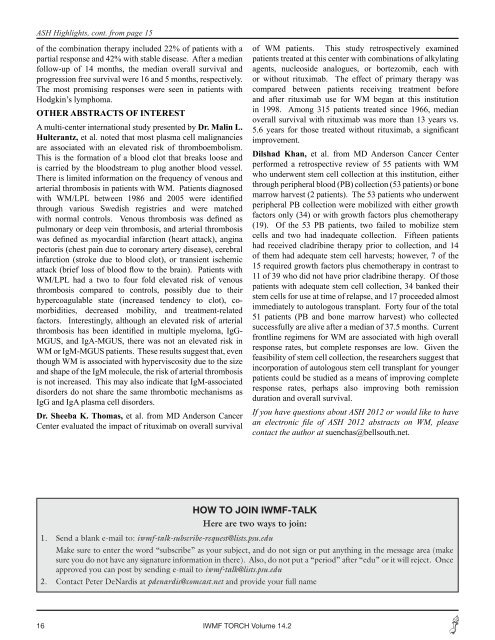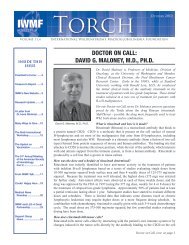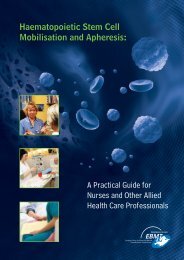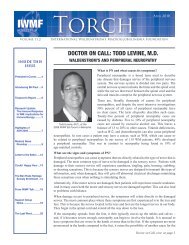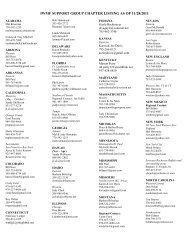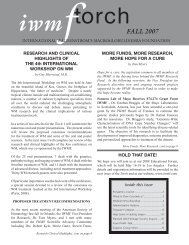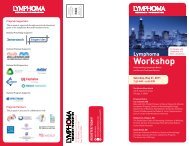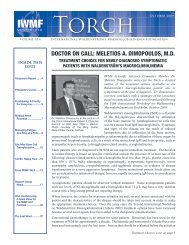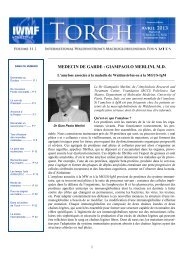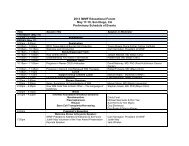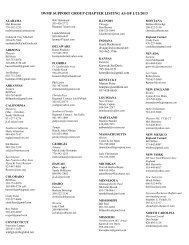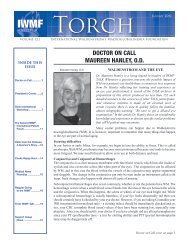English - International Waldenstrom's Macroglobulinemia Foundation
English - International Waldenstrom's Macroglobulinemia Foundation
English - International Waldenstrom's Macroglobulinemia Foundation
You also want an ePaper? Increase the reach of your titles
YUMPU automatically turns print PDFs into web optimized ePapers that Google loves.
ASH Highlights, cont. from page 15<br />
of the combination therapy included 22% of patients with a<br />
partial response and 42% with stable disease. After a median<br />
follow-up of 14 months, the median overall survival and<br />
progression free survival were 16 and 5 months, respectively.<br />
The most promising responses were seen in patients with<br />
Hodgkin’s lymphoma.<br />
OTHER ABSTRACTS OF INTEREST<br />
A multi-center international study presented by Dr. Malin L.<br />
Hultcrantz, et al. noted that most plasma cell malignancies<br />
are associated with an elevated risk of thromboembolism.<br />
This is the formation of a blood clot that breaks loose and<br />
is carried by the bloodstream to plug another blood vessel.<br />
There is limited information on the frequency of venous and<br />
arterial thrombosis in patients with WM. Patients diagnosed<br />
with WM/LPL between 1986 and 2005 were identified<br />
through various Swedish registries and were matched<br />
with normal controls. Venous thrombosis was defined as<br />
pulmonary or deep vein thrombosis, and arterial thrombosis<br />
was defined as myocardial infarction (heart attack), angina<br />
pectoris (chest pain due to coronary artery disease), cerebral<br />
infarction (stroke due to blood clot), or transient ischemic<br />
attack (brief loss of blood flow to the brain). Patients with<br />
WM/LPL had a two to four fold elevated risk of venous<br />
thrombosis compared to controls, possibly due to their<br />
hypercoagulable state (increased tendency to clot), comorbidities,<br />
decreased mobility, and treatment-related<br />
factors. Interestingly, although an elevated risk of arterial<br />
thrombosis has been identified in multiple myeloma, IgG-<br />
MGUS, and IgA-MGUS, there was not an elevated risk in<br />
WM or IgM-MGUS patients. These results suggest that, even<br />
though WM is associated with hyperviscosity due to the size<br />
and shape of the IgM molecule, the risk of arterial thrombosis<br />
is not increased. This may also indicate that IgM-associated<br />
disorders do not share the same thrombotic mechanisms as<br />
IgG and IgA plasma cell disorders.<br />
Dr. Sheeba K. Thomas, et al. from MD Anderson Cancer<br />
Center evaluated the impact of rituximab on overall survival<br />
of WM patients. This study retrospectively examined<br />
patients treated at this center with combinations of alkylating<br />
agents, nucleoside analogues, or bortezomib, each with<br />
or without rituximab. The effect of primary therapy was<br />
compared between patients receiving treatment before<br />
and after rituximab use for WM began at this institution<br />
in 1998. Among 315 patients treated since 1966, median<br />
overall survival with rituximab was more than 13 years vs.<br />
5.6 years for those treated without rituximab, a significant<br />
improvement.<br />
Dilshad Khan, et al. from MD Anderson Cancer Center<br />
performed a retrospective review of 55 patients with WM<br />
who underwent stem cell collection at this institution, either<br />
through peripheral blood (PB) collection (53 patients) or bone<br />
marrow harvest (2 patients). The 53 patients who underwent<br />
peripheral PB collection were mobilized with either growth<br />
factors only (34) or with growth factors plus chemotherapy<br />
(19). Of the 53 PB patients, two failed to mobilize stem<br />
cells and two had inadequate collection. Fifteen patients<br />
had received cladribine therapy prior to collection, and 14<br />
of them had adequate stem cell harvests; however, 7 of the<br />
15 required growth factors plus chemotherapy in contrast to<br />
11 of 39 who did not have prior cladribine therapy. Of those<br />
patients with adequate stem cell collection, 34 banked their<br />
stem cells for use at time of relapse, and 17 proceeded almost<br />
immediately to autologous transplant. Forty four of the total<br />
51 patients (PB and bone marrow harvest) who collected<br />
successfully are alive after a median of 37.5 months. Current<br />
frontline regimens for WM are associated with high overall<br />
response rates, but complete responses are low. Given the<br />
feasibility of stem cell collection, the researchers suggest that<br />
incorporation of autologous stem cell transplant for younger<br />
patients could be studied as a means of improving complete<br />
response rates, perhaps also improving both remission<br />
duration and overall survival.<br />
If you have questions about ASH 2012 or would like to have<br />
an electronic file of ASH 2012 abstracts on WM, please<br />
contact the author at suenchas@bellsouth.net.<br />
HOW TO JOIN IWMF-TALK<br />
Here are two ways to join:<br />
1. Send a blank e-mail to: iwmf-talk-subscribe-request@lists.psu.edu<br />
Make sure to enter the word “subscribe” as your subject, and do not sign or put anything in the message area (make<br />
sure you do not have any signature information in there). Also, do not put a “period” after “edu” or it will reject. Once<br />
approved you can post by sending e-mail to iwmf-talk@lists.psu.edu<br />
2. Contact Peter DeNardis at pdenardis@comcast.net and provide your full name<br />
16 IWMF TORCH Volume 14.2


